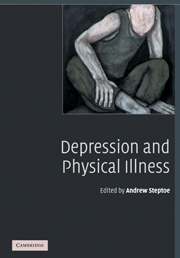Book contents
- Frontmatter
- Contents
- List of contributors
- Preface
- Part 1 Introduction to depression and its determinants
- Part 2 Depression and specific health problems
- Part 3 Biological and behavioural processes
- 12 Inflammation, sickness behaviour and depression
- 13 The hypothalamic–pituitary–adrenal axis: cortisol, DHEA and mental and behavioural function
- 14 Depression and immunity: biological and behavioural mechanisms
- 15 Smoking and depression
- 16 Depression and physical activity
- 17 Depression and adherence to medical advice
- Part 4 Conclusions
- Index
- References
12 - Inflammation, sickness behaviour and depression
from Part 3 - Biological and behavioural processes
Published online by Cambridge University Press: 17 September 2009
- Frontmatter
- Contents
- List of contributors
- Preface
- Part 1 Introduction to depression and its determinants
- Part 2 Depression and specific health problems
- Part 3 Biological and behavioural processes
- 12 Inflammation, sickness behaviour and depression
- 13 The hypothalamic–pituitary–adrenal axis: cortisol, DHEA and mental and behavioural function
- 14 Depression and immunity: biological and behavioural mechanisms
- 15 Smoking and depression
- 16 Depression and physical activity
- 17 Depression and adherence to medical advice
- Part 4 Conclusions
- Index
- References
Summary
Introduction
The prevalence of depression in medically ill patients is high, ranging from 5% to 20% versus 3–5% in the general population. The comorbidity of depressive disorders in general hospital patients or in-patients with chronic pathologies who consult general practitioners (GPs) is about 40% [1, 2]. The rates are similar in women with breast cancer [3]. Several studies have shown that patients with chronic diseases, including arthritis and coronary heart disease (CHD), are more at risk than healthy subjects for developing mood disorders [4–7]. In most of these studies, depression was identified as a significant risk factor for mortality and health/treatment complications. Depression was associated with greater physical limitation, more frequent subjective health complaints, lower treatment compliance and satisfaction, and reduced perceived quality of life. In addition, the prevalence of major depression in later life was also found to be more frequent among people with chronic illnesses [8].
Psychological factors are usually put forward to explain the comorbidity of depression with medical illnesses. Medically ill patients often suffer from physical limitations and have difficulties maintaining positive social relationships. They frequently report feelings of hopelessness, since they cannot cope with the problems they are confronted with, especially in situations of poor social support. These factors increase the risk for the occurrence of depressive disorders. Lack of compliance with medical treatments, decreased social support and the consequences of biological changes associated with depression (e.g. impaired cellular immune functions) are believed to account for the association between depression and increased morbidity and mortality.
Keywords
- Type
- Chapter
- Information
- Depression and Physical Illness , pp. 265 - 279Publisher: Cambridge University PressPrint publication year: 2006
References
- 3
- Cited by

